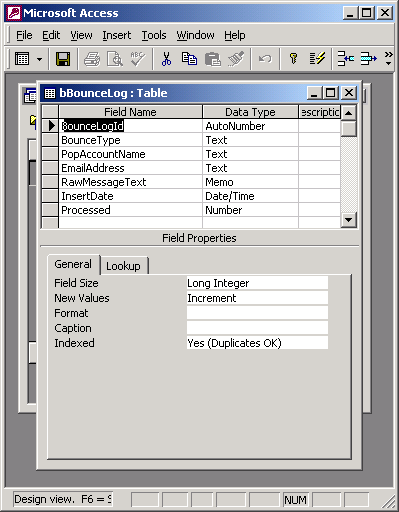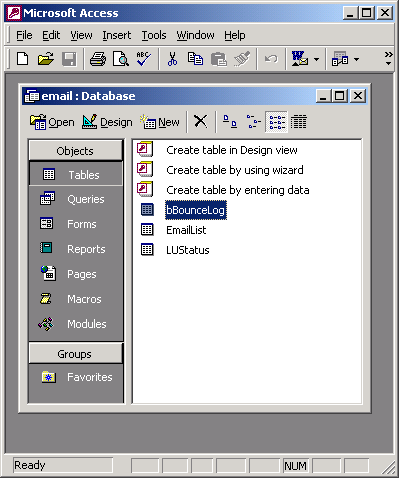If you downloaded the MS Access 2000 database provided on page 1 of this article,
then skip to the end of this page by clicking
here.
The first thing you need to do is create your email bounce log table within your
MS Access database. You can create the email bounce log table in an existing database that
you are already using, or you can create a new one. The database I'll be using for this article is one that
already exists and is something I use quite regularly. Either way, using your Microsoft Access application,
you'll need to create the new table with the following attributes.
Table Name: bBounceLog
| BounceLogId | AutoNumber | Long Integer | Yes (no duplicates) | | |
| BounceType | Text | 4 | Yes (duplicates ok) | no | |
PopAccountName | Text | 20 | No | no | |
| EmailAddress | Text | 255 | No | yes | |
| RawMessageText | Memo | n/a | No | yes | |
| InsertDate | Date/Time | n/a | Yes (duplicates ok) | | Now() |
| Processed | Number | Long Integer | Yes (duplicates ok) | | 0 |
Note: The table name is prefixed with the letter "b" to help insure we don't create a table name that
may already exist in your database. The 'b' stands for BoogieTools.
When you are done adding the fields to your new table, you should see a screen that
looks similar to the image below. Click File-Save, and when prompted for the name of the table,
enter bBounceLog. You can ignore the dialog box that appears stating "there is no primary key
defined". Just click the "no" button. You can make the BounceId field the primary key if you would like,
but it is not necessary for this article.

After saving your new table, you will see a table named bBounceLog in the Access
database window (see image below). Note that you see a couple of extra tables in the image below too. These
tables existed in my database before creating my bBounceLog table. The table called "EmailList" is the table
that stores all of my opt-in email addresses. You may or may not have additional tables in your database.
I'll use these additional tables in Part 2 of this article.

Write Down Your Database Name And The Folder You Saved It Too
Before continuing, make a note of your MS Access database name, and the windows folder
where you saved it. For instance, the name of my Access database is email.mdb, and
I saved it in my c:\temp folder. You'll need this information later on in this
article.